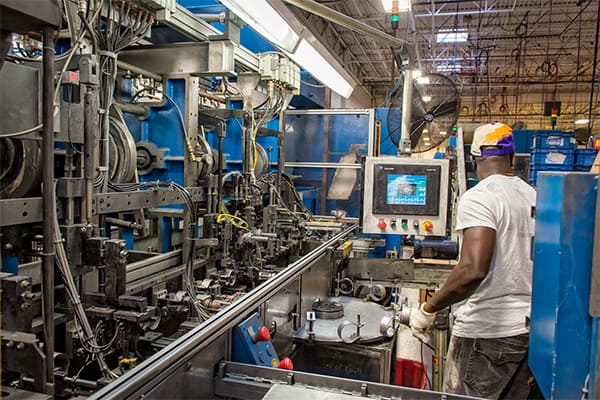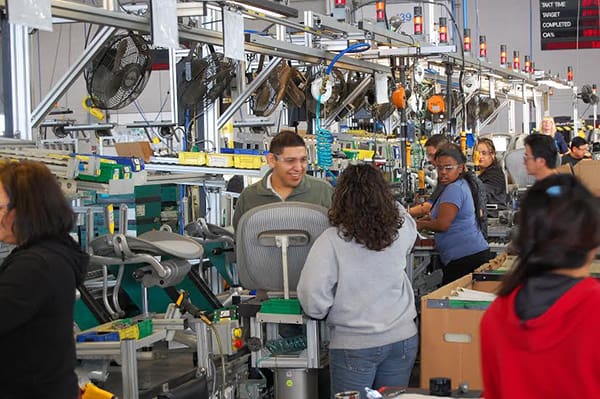North Star Organics cherry orchard in Frankfort, MI.
Recession hit Michigan earlier and deeper than most states during the last decade, digging an economic hole that residents and businesses have been trying to climb out of for years.
But while the Great Lake State’s productivity and employment numbers haven’t quite returned to pre-recession levels, the state does seem to be on track for a comeback, with momentum for a recovery coming from Michigan’s historically strong agriculture and manufacturing sectors.
According to the Michigan Economic Development Corporation (MEDC), the state gained an estimated 1,973 agriculture jobs in the agribusiness cluster in 2014, a rise of 2.8 percent, based on economic modeling data. Meanwhile, manufacturing cluster jobs rose 2.1 percent from 2013 for an estimated total of 11,506 new jobs.
So things are looking up for two of the state’s most well-established industrial sectors.
With this in mind, Bright Ideas decided to take a look at the past, present and future of the agriculture and the manufacturing industries in the Mitten State — with an eye towards the status of three iconic products: cars, chairs and cherries.
Michigan Crops with a Cherry on Top
When federal surveyors visited Michigan following the War of 1812, they wrote it off as boggy swampland inhospitable to agriculture. But when the Erie Canal opened up travel, settlers flocked in and the impression changed. Around the time of statehood, farming surpassed the fur trade as Michigan’s primary commercial activity. By the late 1800s, Michigan was known around the country as a top national wheat producer, and its farmers had established wool, apples, peaches, sugar beets, mint and celery as important commodities.
Thanks to technological advances and an abundance of different soils, landscapes and microclimates, Michigan is now home to over 300 different crops and commodities, making it the second most agriculturally diverse state in the nation after California.
And the state’s agriculture industry has proven resilient, prospering even as manufacturing declined during the Great Recession of 2007 and the one-state economic downturn that preceded it. A Michigan State University study found that the impact of Michigan’s food and agriculture sector grew about 50 percent between 2004 and 2010, contributing an estimated $91.4 billion to the state economy in the final year of the study. The MEDC estimates sales in the state’s agribusiness cluster reached $11.3 billion in 2013, an increase of about 4.2 percent over the previous year.
Carsten Hohnke, the MEDC’s senior vice president of strategy and policy, says the health of the agriculture sector is strong right now, with soybeans leading the way as the biggest component of the export market.
“You see it not only in big row crops and the strength of soybeans, but in the diversity of agricultural activities in the state,” he says. “You’re seeing great movement forward in the whole breadth of what we do in agriculture.”
Hohnke says the Michigan is in a good position to increase commodity exports and encourage foreign direct investment in the sector, noting that the state has set up an office in Shanghai, China to take advantage of these opportunities.
Hohnke’s agency also works with Michigan’s Department of Agriculture and Rural Development and other stakeholders to promote projects by investors closer to home, noting the agency’s role in the Dairy Farmers of America’s decision to build a $40 billion milk processing plant in Cass City, and in a quarter-of-a-million-dollar investment by the Clemens Food Group of Pennsylvania in a new Coldwater pork processing plant.
In line with the broader agricultural sector, the cherry business is also going strong. That’s good news, indeed, as Michigan produces between 70 to 75 percent of the tart cherries grown in the nation.

Tart cherries ready for harvest at North Star Organics in Frankfort, Michigan.
Jeff Send is the owner of Cherry Lane Farms, based in Suttons Bay, and president of the National Cherry Growers and Industries Foundation, which represents 230 Michigan cherry growers.
Despite last year’s blistering cold, he says 2014’s cherry harvest was solid.
“With the hard winter, it means there’s ice on the pond longer, so that holds our spring back,” he says. “[That] means we have a better chance of setting a full crop, and that’s what we did. It was probably one of our better years ever.”
Michigan farmers produced nearly 18,200 tons of brined cherry packs in 2014, an increase of almost 3,700 from the previous year.
Next year may not be quite so juicy, however. Send predicts this coming year’s sweet cherry harvest could be weaker, a result of the heavy crop this year.
Making It in the Great Lakes
Michigan’s international reputation as a place where things get made has its roots back to the seventeenth century French fur trade, and natural resources played a big role in shaping the region into an industrial powerhouse.
After the Civil War, Michigan supplied nearly a quarter of the nation’s lumber. The presence of these raw materials helped spur on furniture manufacturing in Grand Rapids and paper-making in Kalamazoo, and provided capital for other industries to grow.
Detroit, for example, started out as a transportation hub, but later evolved into an important center for the manufacture of stoves and bicycles. Henry Ford’s adoption of the assembly line in his factories and his then unheard-of daily wage of five dollars helped bring about an automotive boom that brought immigrants to the state in droves and made the state’s industry famous around the globe.
And despite the downturn of recent years, MEDC’s Hohnke says the state’s manufacturing is rebounding.
“Manufacturing has really led the comeback in Michigan,” he says. “We’ve seen manufacturing growth lead the recovery since the second quarter of 2009 to significant job growth, the strongest in the country.”
In 2013, Michigan’s manufacturing cluster pulled in an estimated $295 billion in sales, a 5.3 percent jump over 2012. Hohnke expects this success to bolster other sectors, such as professional services.
Auto sales are guiding the boom, and Kristin Dziczek, director of the Industry & Labor Group at the Center for Automotive Research (CAR), says that industry is doing quite well at the moment.
“I just came from the [North American International] Auto Show and the Big Three are very strong … and that’s a completely different picture than it was a few years ago,” she says. “Our employment is not back to the level that it once was, [but] Michigan has gained about 48,000 jobs, 41 percent since 2009. Automotive parts manufacturing and motor vehicle production is up 97 percent from 2009, so now we’re making 2.2 million vehicles a year in Michigan.”
NORMA Group manufactures engineered joining technology for cooling systems, air intake & induction and emission control in Auburn Hills, Michigan. Photo credit: Doug Coombe.
She adds that 63 of the top 100 auto suppliers — who are responsible for much of the tech innovation in the industry — are headquartered in Michigan; along with other supply companies, and they’re riding the same wave of productivity.
The birds seem to be singing for the the state’s furniture manufacturers, too.
Greg Bylsma, chief financial officer of Zeeland-based Herman Miller, has rosy things to say about his company’s performance.
“We are seeing significant year-over-year sales growth this year,” he says.
For fiscal year 2015, the company expect sales to range between $2.145 billion and $2.185 billion, with revenue growth between 14 and 16 percent over fiscal 2014.
Thomas Reardon is executive director of BIFMA (Business + Institutional Furniture Manufacturers Association), a national industry group that represents about ten Michigan companies including Herman Miller, Steelcase and Haworth. He says the industry is experiencing a period of moderate growth and many companies are hiring new employees.
“West Michigan remains a hub of commercial furniture production, and many supplier companies are also located here as a result,” he says.
Herman Miller manufactures furniture in Zeeland, Michigan. Photo courtesy of Herman Miller.
Moving into the Future
On the whole, Hohnke is upbeat about the prospects of the Great Lake’s State agriculture and manufacturing sectors.
He expects Michigan’s manufacturing companies to benefit from the presence of new research centers like the American Lightweight Metals Manufacturing Innovation Institute in Detroit’s Corktown neighborhood and Michigan State University’s new Facility for Rare Isotope Beams in East Lansing.
As for agriculture, he’s enthusiastic about new water pipeline project that will connect Lake Huron to Flint, which could be a boon to farmers in the state’s Thumb region.
He’s also excited about the prospect of Michigan agricultural firms teaming up with local companies skilled in product fabrication. “What we’re seeing is a really exciting expansion in value-added food processing.” he says.
“In general, I think both sectors are looking like they will continue to help lead Michigan’s recovery,” he says. “I’m excited not just about the rebounding of both of those sectors, but also the new opportunities in both that are specific to Michigan.”
Notes:
(1) The MEDC statistics in this report rely on economic modeling from Economic Modeling Specialists Intl. (EMSI) http://www.economicmodeling.com/analyst/, a firm that compiles data from over 90 different sources. This first reference to agricultural and manufacturing jobs contains some overlap, as the data uses North American Industry Classification System (NAICS) codes that apply to both sectors.
(2)These agribusiness sales figures here do not include agribusiness manufacturing firms as defined by NAICS codes.





